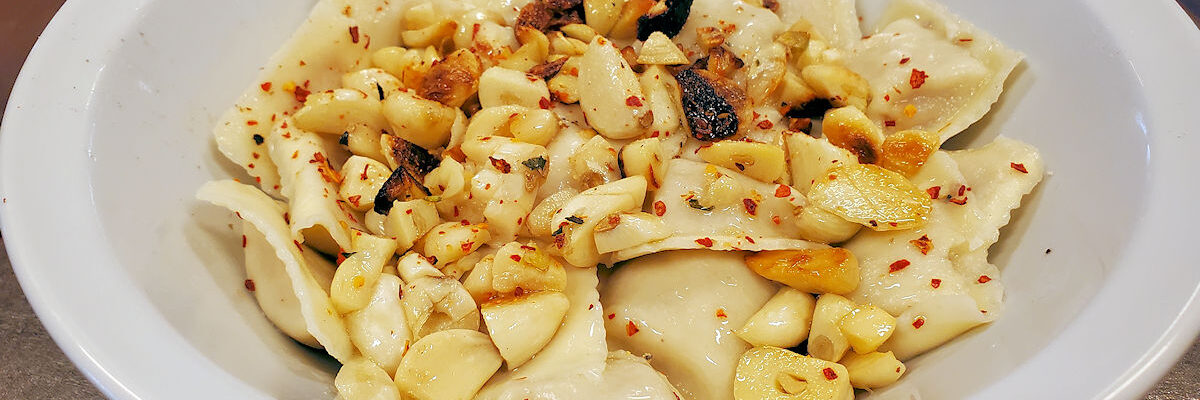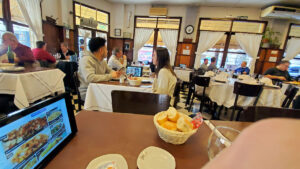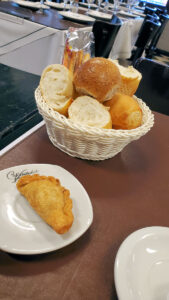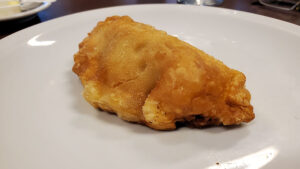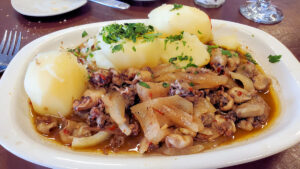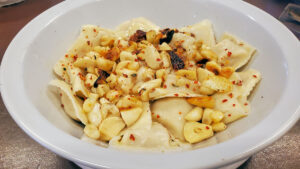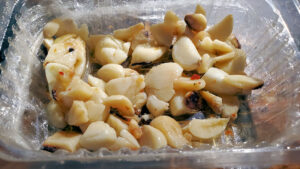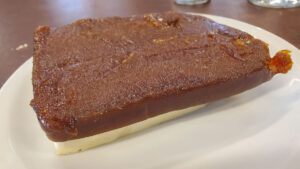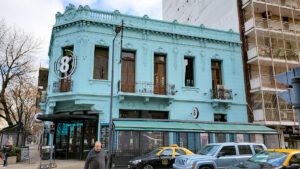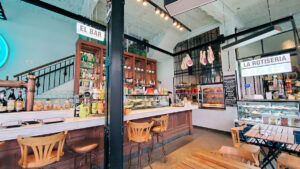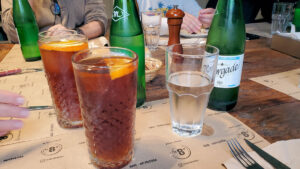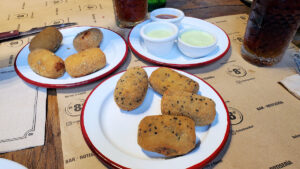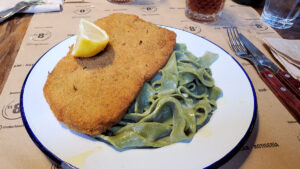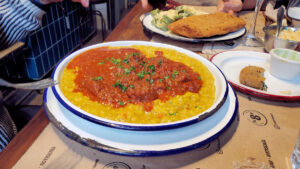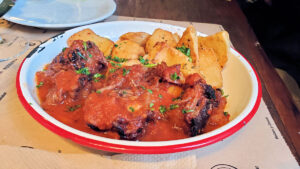A bodegón is a classic institution of local gastronomy. It’s an interesting word in that its original meaning is a “still life”, as in a painting of domestic objects, usually food related, captured in time. At some point in the mid 19th century it came to refer to a particular type of tavern. While there are no hard and fast rules, there are certainly customary signs that you’re in a bodegón, the decor tends to be older in style, lots of dark wood, memorabilia, photos – usually of celebrities or sports figures, some hanging garlic, salamis, or hams, the classic touch of an old time cash register is not out of place.
The food – a mix of the traditional local “diner” type dishes of Argentine cuisine, usually interspersed with something “ethnic” to indicate the heritage of the family that owns the place. Most often that will be some specific regional dishes to some part of Spain or Italy, and to a lesser extent, Germany. People have their favorite spots to go, their favorite tables to sit at, their favorite waiters to serve them, and, their favorite dishes – most places have one or two specialties that they’re known for. Generous portions, simple but delicious (one hopes) preparations, are hallmarks. If Cheers had been a restaurant rather than a bar, it would have been a bodegón.
Certainly over my years here (just last week I celebrated seventeen years in Buenos Aires), I’ve been to many of them. Some favorites… Venison ravioli in mushroom cream sauce at Miramar. Top round steak in mustard sauce at Cantina Pantaleón. Fried smelt at Gijon. Fried calamari at Pucará. The Suprema Maryland at Manolo. Grilled sweetbreads at Lalo. Turkey escabeche at Café Margot. Revuelto Gramajo from Liber. The roast chicken at Albamonte (which, it appears, I’ve never written up, nor taken a photo of). Tortilla española or montañesa at Centro Montañes.
Let’s see if we can find some more…
Il Vero Arturito, San Luis 2999, Balvanera (Once) – This place has to be one of the oldest on my map of spots to try. I mean, it may actually be one of the oldest spots, but specifically, I think it’s one of the first places I ever put on the map, and it just sort of got lost over time. Old school it may be, but they’ve gone high tech when it comes to ordering. Every table has a full color tablet with an interactive menu that allows you to get descriptions of dishes, and even customize many of them. It’s not a totally intuitive system, for example to indicate that you want some dishes as appetizers and others as main courses – there’s a button, but it’s not always prominent on every dish. Still, overall the system works reasonably well. Two solo visits (second visit was intended to be two of us, but there was an hour wait for a table, so we went elsewhere and I returned on my own another day).
A basket of bread for the table, and a mini-empanada, beef, for everyone at the table. Have to do something to justify the 150 peso cubierto charge… well, the first visit. By ten days later, on the second visit, it was up to 200.
The empanada is good, though the beef one is only available as the free mini. On the menu, the only option is a chicken empanada, deep fried to a gorgeous, crackly crusted golden brown. The filling is juicy, flavorful, everything you might want in a chicken empanada, and one of the best I’ve had in BA. 250 pesos.
Il Vero Arturito (which also has a second location in Palermo) is known, it seems, for two things – their seafood, and their filled pastas. On the first visit I went for the former, and a dish that I really enjoy when I can find it, calamaretes a la lyonesa. Baby squid, stewed in a white wine sauce, that when done right is packed with garlic and chili. This one is. Flavorwise, this is one of the best versions of the dish I’ve ever had. However, I was a bit disappointed that they didn’t remove the quills from any of the calamaretes. It’s a pain in the ass chore to do, but one by one, I had to pull the quills out after discovering they were there. Otherwise, they’re like little chewy strips of plastic. 1800 pesos.
On the filled pasta side… wow… look at all that garlic. I ordered up the turkey, ham, and almond filled ravioli, the most interesting, and offbeat, sounding filled pasta on the menu. 1500 pesos. The choice of sauces is legion… there must be close to two dozen of them available (ranging from free to 600 pesos, it’s a separate charge from the pasta). I picked the ajillo, sauce, which is basically just olive oil with garlic and chili in it. A lot of both, but particularly the former. I guess you have to get something for the 600 peso price-tag on the sauce – and in this case it’s roughly two full heads of garlic, coarsely broken up and lightly browned. And it really is that much…
I ended up taking half the ravioli home, because it was just too much to eat (roughly two dozen ravioli, that’s a whopping amount for one person). And even with having a piece or two of garlic with each ravioli, I still had this much left at the end. Not to worry, it didn’t go to waste. Oh, and, btw, for a garlic lover, this was heaven. And if you want garlic only, without the chili, they have that option too.
Their take on a vigilante, the classic cheese and dulce de membrillo, quince paste, dessert. I included a bit of the history of this dish way back. This version is a huge slab of each. I didn’t even make it through a third of it. And it was… good… but no more than that – the cheese was a bit bland. 600 pesos.
Given the huge portions, the prices are quite reasonable. In both cases I ended up with food to take home that became a second meal. I’d venture that most of the main course dishes could probably be shared, especially if you had appetizers first. Now, the question, given that the waiters do nothing more than deliver food to the table – there’s literally no other interaction with them – does one still tip in full? I did, but, it did occur to me that they’re not really doing a good portion of the work that waiters typically do. Though I’m sure you could flag them down and ask questions, in fact, I’m pretty sure I saw a few people do that.
Next up, El Octavo, Bulnes 1408, Palermo. It’s named “the eighth”, if I understand correctly, because it’s the eighth bodegón or café that the family opened. I don’t know who chose, or why, the vaguely aqua color that dominates outside and in. I also gather that the rotisería, the sort of takeout window of specialties is relatively new, from during the height of the pandemic. We noted, in particular, the spit roasted chickens over a bed of oranges, perfuming them. I was here with a group of friends, most of them visiting for this year’s “beer cup”, an event I went to a few years back in Mar del Plata, plus a couple of local friends. (Here, a little video tour of the place I found on YouTube, in Spanish.)
Among the things El Octavo is noted for is their vermut al grifo, red vermouth on tap. That’s a whopping glass of vermouth – a good 10-12 ounces with just enough ice to keep it cold. It’s also really good – and such a classic Buenos Aires tradition. Screw the wine and beer! 450 pesos.
Two things that the place is known for are their croquettes and their milanesas. I didn’t get pictures of everything people ate (we were a group of nine, so I just focused on plates close to me). Here, portobello and spinach croquettes, and four-cheese ones. Served up with two dipping sauces, a homemade ketchup with a touch of curry, and cilantro mayo. Yum all around. I could just sit there with my vermouth and a couple of plates of croquettes and be happy. There are eight different varieties available, most of them 550 pesos for a plate of four (two, the prosciutto, and the prawn, are more expensive, at 730 and 850 a plate).
Three different milanesas are available, two beef, one chicken. The latter comes with a fried egg and cherry tomatoes atop. The beef ones, first of all distinguished by being bife de chorizo, or a boneless porterhouse, are available either simply, with a wedge of lemon, and accompanied by housemade spinach fettuccine in a cream sauce, or napolitana with ham, tomato sauce, and mozzarella, with roasted potatoes. 1450, 1540, and 1680 pesos, respectively. Fantastic milanesa. The pasta itself, silky and perfectly cooked. The cream sauce needs work, and more abundance.
An osso buco risotto was good. Actually, the stewed osso buco was excellent. The risotto just wasn’t quite right – a bit stodgy. 1750 pesos.
The slow braised oxtail in a wine, tomato, and peppers sauce was very good, and properly tender, falling off the bone. 1400 pesos. I know someone ordered the spit-roasted chicken and said it was very good. As were, apparently, a bowl of gazpacho, a couple of the other croquette varieties, and a tarta gallega.
Overall, very happy campers, and a place I’ll happily return to again. After checking out a zillion other bodegones, of course.
